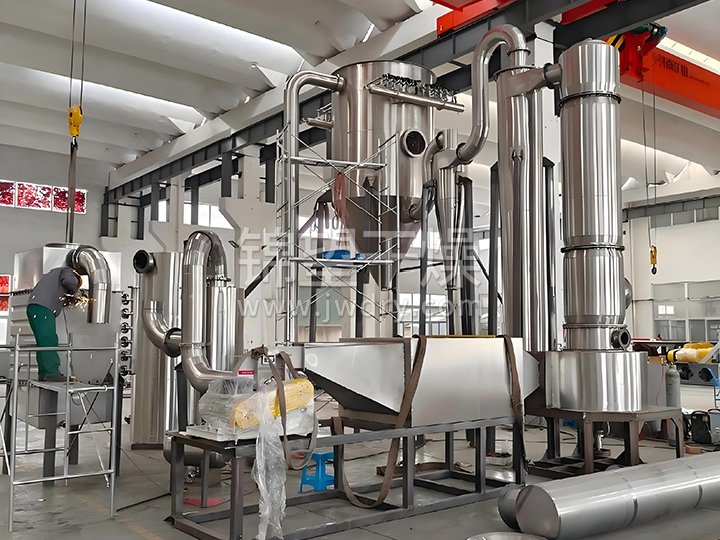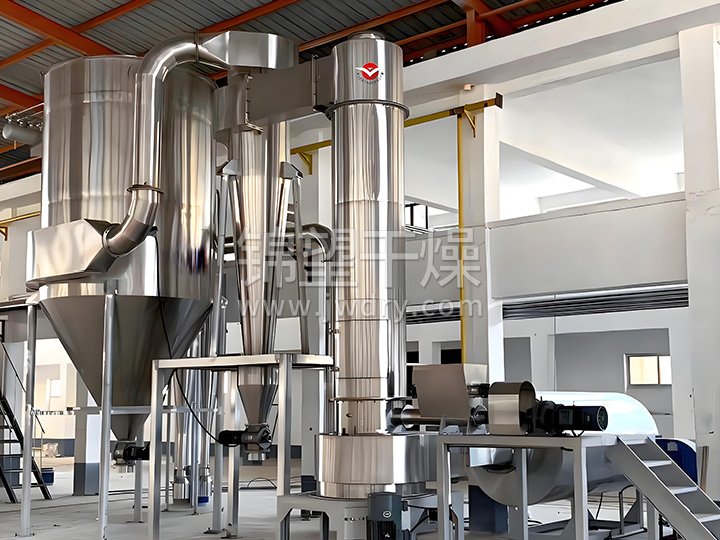● Project Overview:
Battery materials special rapid rotary flash dryer is a step in Changzhou on the basis of the existing mature flash drying technology, research and development used to dry paste viscous, filter cake and heat-sensitive materials, a new type of drying equipment. It is used in chemical, pharmaceutical, biological, new energy and other technical fields, characterized by safety, environmental protection, energy saving and consumption reduction, and suitable for the special requirements of battery material production.
● Equipment description:
Special fast rotary flash dryer for battery materials consists of drying mainframe, heater, cloth bag dust collector, condenser, fan and silo and other parts. The hot air enters into the bottom of the dryer tangentially and forms a strong rotating wind field driven by the agitator. Paste material from the spiral feeder into the dryer, under the strong action of high-speed rotating stirring paddle, the material is dispersed by the impact, friction and shear force, the lumpy material is crushed quickly, and the hot air is fully contacted, heated and dried. After dehydration, the dry material rises with the hot airflow, the grading ring retains the large particles, the small particles are discharged from the center of the ring to the outside of the dryer, which is recovered by the cyclone separator and dust collector, and the undried or large materials are thrown to the wall by the centrifugal force, and then fall down to the bottom of the machine to be crushed and dried again.
●Technical description of the equipment:
1, in order to be able to dry the material to be dried continuously, uniformly, quantitatively transported into the drying host for drying operations, in the wet hopper near the part of the spiral is set up to break the arch of the mixing device, the speed and the spiral speed is the same. At the same time, for the battery material filter cake has the characteristics of viscous, conveying spiral design into a double spiral structure, the spiral piece staggered each other set, and cut into each other. This is easy to destroy each other viscous materials, “hold the shaft” phenomenon, double screw with self-cleaning function, and the use of frequency converter to adjust the speed.
2, in the host within the cone of the inner side of the insulation layer, reduce the host heat to the bearing parts of the transmission.
3、Rotary flash drying is a kind of continuous rapid fluidization state drying, belonging to instant drying. According to the drying practice, in the battery material drying, because to control the final moisture of the product is very low, dry smash broken main tower air temperature in 100 ℃ -160 ℃, you can use the high-temperature exhaust, through the residual heat recovery device for drying system preheating, to achieve energy saving and emission reduction purposes.
4, due to the battery particle size is very small, is the breeze level powder, so the bag filter bag in the bag filter is made of PTFE coated material, can be highly efficient filtration of micro-powder. At the same time, the coating material itself has hydrophobicity, in use, can greatly reduce the water and other oily substances adhering to the surface of the filter bag, and thus less dust adhering to the surface of the filter bag, the bag cleaning effect is good, at the same time, the project bag filter configuration of the filter area is large enough, the entire dust collector running conditions, low resistance, high dust removal efficiency.
● Equipment characteristics:
Organic combination of cyclone, fluidization, jetting and crushing and grading technology.
Compact equipment, small size, high production efficiency, continuous production, realizing “small equipment, large production”.
Drying intensity, low energy consumption, high thermal efficiency.
Short residence time of materials, good quality of finished products, can be used for drying heat-sensitive materials.
Negative pressure or micro-negative pressure operation, good airtightness, high efficiency, eliminating environmental pollution.


 Tel
Tel E-mail
E-mail Address
Address
